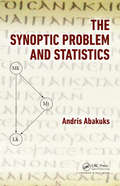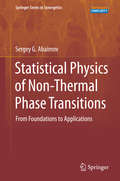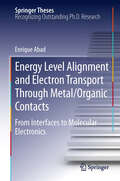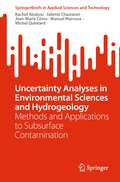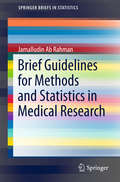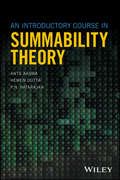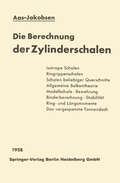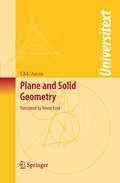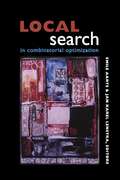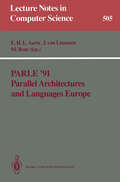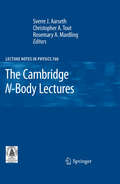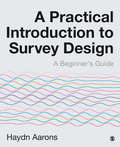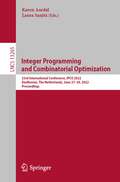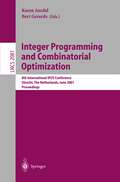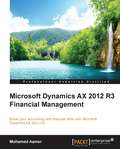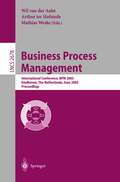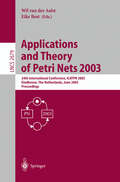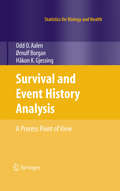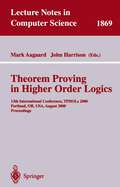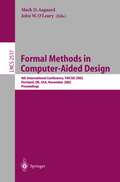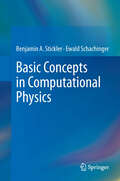- Table View
- List View
The Synoptic Problem and Statistics
by Andris AbakuksSee How to Use Statistics for New Testament InterpretationThe Synoptic Problem and Statistics lays the foundations for a new area of interdisciplinary research that uses statistical techniques to investigate the synoptic problem in New Testament studies, which concerns the relationships between the Gospels of Matthew, Mark, and Luke. There are pote
Statistical Physics of Non-Thermal Phase Transitions: From Foundations to Applications (Springer Series in Synergetics)
by Sergey G. AbaimovThis book addresses the application of methods used in statistical physics to complex systems—from simple phenomenological analogies to more complex aspects, such as correlations, fluctuation-dissipation theorem, the concept of free energy, renormalization group approach and scaling. Statistical physics contains a well-developed formalism that describes phase transitions. It is useful to apply this formalism for damage phenomena as well. Fractals, the Ising model, percolation, damage mechanics, fluctuations, free energy formalism, renormalization group, and scaling, are some of the topics covered in Statistical Physics of Phase Transitions.
Energy Level Alignment and Electron Transport Through Metal/Organic Contacts: From Interfaces to Molecular Electronics (Springer Theses)
by Enrique AbadIn recent years, ever more electronic devices have started to exploit the advantages of organic semiconductors. The work reported in this thesis focuses on analyzing theoretically the energy level alignment of different metal/organic interfaces, necessary to tailor devices with good performance. Traditional methods based on density functional theory (DFT), are not appropriate for analyzing them because they underestimate the organic energy gap and fail to correctly describe the van der Waals forces.Since the size of these systems prohibits the use of more accurate methods, corrections to those DFT drawbacks are desirable. In this work a combination of a standard DFT calculation with the inclusion of the charging energy (U) of the molecule, calculated from first principles, is presented. Regarding the dispersion forces, incorrect long range interaction is substituted by a van der Waals potential. With these corrections, the C60, benzene, pentacene, TTF and TCNQ/Au(111) interfaces are analyzed, both for single molecules and for a monolayer. The results validate the induced density of interface states model.
Uncertainty Analyses in Environmental Sciences and Hydrogeology: Methods and Applications to Subsurface Contamination (SpringerBriefs in Applied Sciences and Technology)
by Rachid Ababou Juliette Chastanet Jean-Marie Côme Manuel Marcoux Michel QuintardThis book highlights several methods and quantitative implementations of both probabilistic and fuzzy-based approaches to uncertainty quantification and uncertainty propagation through environmental subsurface pollution models with uncertain input parameters. The book focuses on methods as well as applications in hydrogeology, soil hydrology, groundwater contamination, and related areas (e.g., corrosion of nuclear waste canisters). The methods are illustrated for a broad spectrum of models, from non-differential I/O models to complex PDE solvers, including a novel 3D quasi-analytical model of contaminant transport, and a site-specific computer model of dissolved contaminant migration from a DNAPL (Dense Non Aqueous Phase Liquid) pollution source.
Brief Guidelines for Methods and Statistics in Medical Research (SpringerBriefs in Statistics #0)
by Jamalludin Bin Ab RahmanThis book serves as a practical guide to methods and statistics in medical research. It includes step-by-step instructions on using SPSS software for statistical analysis, as well as relevant examples to help those readers who are new to research in health and medical fields. Simple texts and diagrams are provided to help explain the concepts covered, and print screens for the statistical steps and the SPSS outputs are provided, together with interpretations and examples of how to report on findings. Brief Guidelines for Methods and Statistics in Medical Research offers a valuable quick reference guide for healthcare students and practitioners conducting research in health related fields, written in an accessible style.
An Introductory Course in Summability Theory
by Ants Aasma Hemen Dutta P. N. NatarajanAn introductory course in summability theory for students, researchers, physicists, and engineers In creating this book, the authors’ intent was to provide graduate students, researchers, physicists, and engineers with a reasonable introduction to summability theory. Over the course of nine chapters, the authors cover all of the fundamental concepts and equations informing summability theory and its applications, as well as some of its lesser known aspects. Following a brief introduction to the history of summability theory, general matrix methods are introduced, and the Silverman-Toeplitz theorem on regular matrices is discussed. A variety of special summability methods, including the Nörlund method, the Weighted Mean method, the Abel method, and the (C, 1) - method are next examined. An entire chapter is devoted to a discussion of some elementary Tauberian theorems involving certain summability methods. Following this are chapters devoted to matrix transforms of summability and absolute summability domains of reversible and normal methods; the notion of a perfect matrix method; matrix transforms of summability and absolute summability domains of the Cesàro and Riesz methods; convergence and the boundedness of sequences with speed; and convergence, boundedness, and summability with speed. • Discusses results on matrix transforms of several matrix methods • The only English-language textbook describing the notions of convergence, boundedness, and summability with speed, as well as their applications in approximation theory • Compares the approximation orders of Fourier expansions in Banach spaces by different matrix methods • Matrix transforms of summability domains of regular perfect matrix methods are examined • Each chapter contains several solved examples and end-of-chapter exercises, including hints for solutions An Introductory Course in Summability Theory is the ideal first text in summability theory for graduate students, especially those having a good grasp of real and complex analysis. It is also a valuable reference for mathematics researchers and for physicists and engineers who work with Fourier series, Fourier transforms, or analytic continuation. ANTS AASMA, PhD, is Associate Professor of Mathematical Economics in the Department of Economics and Finance at Tallinn University of Technology, Estonia. HEMEN DUTTA, PhD, is Senior Assistant Professor of Mathematics at Gauhati University, India. P.N. NATARAJAN, PhD, is Formerly Professor and Head of the Department of Mathematics, Ramakrishna Mission Vivekananda College, Chennai, Tamilnadu, India.
An Introductory Course in Summability Theory
by Ants Aasma Hemen Dutta P. N. NatarajanAn introductory course in summability theory for students, researchers, physicists, and engineers In creating this book, the authors’ intent was to provide graduate students, researchers, physicists, and engineers with a reasonable introduction to summability theory. Over the course of nine chapters, the authors cover all of the fundamental concepts and equations informing summability theory and its applications, as well as some of its lesser known aspects. Following a brief introduction to the history of summability theory, general matrix methods are introduced, and the Silverman-Toeplitz theorem on regular matrices is discussed. A variety of special summability methods, including the Nörlund method, the Weighted Mean method, the Abel method, and the (C, 1) - method are next examined. An entire chapter is devoted to a discussion of some elementary Tauberian theorems involving certain summability methods. Following this are chapters devoted to matrix transforms of summability and absolute summability domains of reversible and normal methods; the notion of a perfect matrix method; matrix transforms of summability and absolute summability domains of the Cesàro and Riesz methods; convergence and the boundedness of sequences with speed; and convergence, boundedness, and summability with speed. • Discusses results on matrix transforms of several matrix methods • The only English-language textbook describing the notions of convergence, boundedness, and summability with speed, as well as their applications in approximation theory • Compares the approximation orders of Fourier expansions in Banach spaces by different matrix methods • Matrix transforms of summability domains of regular perfect matrix methods are examined • Each chapter contains several solved examples and end-of-chapter exercises, including hints for solutions An Introductory Course in Summability Theory is the ideal first text in summability theory for graduate students, especially those having a good grasp of real and complex analysis. It is also a valuable reference for mathematics researchers and for physicists and engineers who work with Fourier series, Fourier transforms, or analytic continuation. ANTS AASMA, PhD, is Associate Professor of Mathematical Economics in the Department of Economics and Finance at Tallinn University of Technology, Estonia. HEMEN DUTTA, PhD, is Senior Assistant Professor of Mathematics at Gauhati University, India. P.N. NATARAJAN, PhD, is Formerly Professor and Head of the Department of Mathematics, Ramakrishna Mission Vivekananda College, Chennai, Tamilnadu, India.
Plane and Solid Geometry (Universitext)
by J.M. AartsThis is a book on Euclidean geometry that covers the standard material in a completely new way, while also introducing a number of new topics that would be suitable as a junior-senior level undergraduate textbook. The author does not begin in the traditional manner with abstract geometric axioms. Instead, he assumes the real numbers, and begins his treatment by introducing such modern concepts as a metric space, vector space notation, and groups, and thus lays a rigorous basis for geometry while at the same time giving the student tools that will be useful in other courses.
Local Search in Combinatorial Optimization
by Emile Aarts Jan Karel LenstraIn the past three decades, local search has grown from a simple heuristic idea into a mature field of research in combinatorial optimization that is attracting ever-increasing attention. Local search is still the method of choice for NP-hard problems as it provides a robust approach for obtaining high-quality solutions to problems of a realistic size in reasonable time. Local Search in Combinatorial Optimization covers local search and its variants from both a theoretical and practical point of view, each topic discussed by a leading authority. This book is an important reference and invaluable source of inspiration for students and researchers in discrete mathematics, computer science, operations research, industrial engineering, and management science. In addition to the editors, the contributors are Mihalis Yannakakis, Craig A. Tovey, Jan H. M. Korst, Peter J. M. van Laarhoven, Alain Hertz, Eric Taillard, Dominique de Werra, Heinz Mühlenbein, Carsten Peterson, Bo Söderberg, David S. Johnson, Lyle A. McGeoch, Michel Gendreau, Gilbert Laporte, Jean-Yves Potvin, Gerard A. P. Kindervater, Martin W. P. Savelsbergh, Edward J. Anderson, Celia A. Glass, Chris N. Potts, C. L. Liu, Peichen Pan, Iiro Honkala, and Patric R. J. Östergård.
Local Search in Combinatorial Optimization (PDF)
by Emile Aarts Jan Karel LenstraIn the past three decades, local search has grown from a simple heuristic idea into a mature field of research in combinatorial optimization that is attracting ever-increasing attention. Local search is still the method of choice for NP-hard problems as it provides a robust approach for obtaining high-quality solutions to problems of a realistic size in reasonable time. Local Search in Combinatorial Optimization covers local search and its variants from both a theoretical and practical point of view, each topic discussed by a leading authority. This book is an important reference and invaluable source of inspiration for students and researchers in discrete mathematics, computer science, operations research, industrial engineering, and management science. In addition to the editors, the contributors are Mihalis Yannakakis, Craig A. Tovey, Jan H. M. Korst, Peter J. M. van Laarhoven, Alain Hertz, Eric Taillard, Dominique de Werra, Heinz Mühlenbein, Carsten Peterson, Bo Söderberg, David S. Johnson, Lyle A. McGeoch, Michel Gendreau, Gilbert Laporte, Jean-Yves Potvin, Gerard A. P. Kindervater, Martin W. P. Savelsbergh, Edward J. Anderson, Celia A. Glass, Chris N. Potts, C. L. Liu, Peichen Pan, Iiro Honkala, and Patric R. J. Östergård.
Parle ’91 Parallel Architectures and Languages Europe: Volume I: Parallel Architectures and Algorithms Eindhoven, The Netherlands, June 10–13, 1991 Proceedings (Lecture Notes in Computer Science #505)
by Emile H. L. Aarts Jan Van Leeuwen Martin RemThe innovative progress in the development oflarge-and small-scale parallel computing systems and their increasing availability have caused a sharp rise in interest in the scientific principles that underlie parallel computation and parallel programming. The biannual "Parallel Architectures and Languages Europe" (PARLE) conferences aim at presenting current research material on all aspects of the theory, design, and application of parallel computing systems and parallel processing. At the same time, the goal of the PARLE conferences is to provide a forum for researchers and practitioners to ex change ideas on recent developments and trends in the field of parallel com puting and parallel programming. The first ~wo conferences, PARLE '87 and PARLE '89, have succeeded in meeting this goal and made PARLE a conference that is recognized worldwide in the field of parallel computation. PARLE '91 again offers a wealth of high-quality research material for the benefit of the scientific community. Compared to its predecessors, the scope of PARLE '91 has been broadened so as to cover the area of parallel algo rithms and complexity, in addition to the central themes of parallel archi tectures and languages. The proceedings of the PARLE '91 conference contain the text of all con tributed papers that were selected for the programme and of the invited papers by leading experts in the field.
The Cambridge N-Body Lectures (Lecture Notes in Physics #760)
by Sverre Aarseth Christopher Tout Rosemary MardlingPublished under the auspices of the Royal Astronomical Society, this volume contains a set of extensive school tested lectures, with the aim to give a coherent and thorough background knowledge of the subject and to introduce the latest developments in N-body computational astrophysics. The topics cover a wide range from the classical few-body problem with discussions of resonance, chaos and stability to realistic modelling of star clusters as well as descriptions of codes, algorithms and special hardware for N-body simulations. This collection of topics, related to the gravitational N-body problem, will prove useful to both students and researchers in years to come.1) Published under the auspices of the Royal Astronomical Society.
A Practical Introduction to Survey Design: A Beginner′s Guide
by Haydn AaronsThis is your definitive guide to designing your social survey. It includes all the knowledge and skills you need to plan your survey with confidence and ease. Every step of survey design from developing your questions, to administering your survey and preparing your data for analysis, is explained in easy to follow language. It features: Case studies demonstrating how effective surveys are conducted in real life Clear advice on how to design an ethical social survey Practical exercises to help you construct your survey Suggestions for further reading taken from cutting edge, multidisciplinary sources The book also comes with a host of useful online resources, including templates and reflective questions, to help strengthen your understanding and apply your new found knowledge.
A Practical Introduction to Survey Design: A Beginner′s Guide
by Haydn AaronsThis is your definitive guide to designing your social survey. It includes all the knowledge and skills you need to plan your survey with confidence and ease. Every step of survey design from developing your questions, to administering your survey and preparing your data for analysis, is explained in easy to follow language. It features: Case studies demonstrating how effective surveys are conducted in real life Clear advice on how to design an ethical social survey Practical exercises to help you construct your survey Suggestions for further reading taken from cutting edge, multidisciplinary sources The book also comes with a host of useful online resources, including templates and reflective questions, to help strengthen your understanding and apply your new found knowledge.
A Practical Introduction to Survey Design: A Beginner′s Guide
by Haydn AaronsThis is your definitive guide to designing your social survey. It includes all the knowledge and skills you need to plan your survey with confidence and ease. Every step of survey design from developing your questions, to administering your survey and preparing your data for analysis, is explained in easy to follow language. It features: Case studies demonstrating how effective surveys are conducted in real life Clear advice on how to design an ethical social survey Practical exercises to help you construct your survey Suggestions for further reading taken from cutting edge, multidisciplinary sources The book also comes with a host of useful online resources, including templates and reflective questions, to help strengthen your understanding and apply your new found knowledge.
Integer Programming and Combinatorial Optimization: 23rd International Conference, IPCO 2022, Eindhoven, The Netherlands, June 27–29, 2022, Proceedings (Lecture Notes in Computer Science #13265)
by Karen Aardal Laura SanitàThis book constitutes the refereed proceedings of the 23rd International Conference on Integer Programming and Combinatorial Optimization, IPCO 2022, held in Eindhoven, The Netherlands, in June 2022. The 33 full papers presented were carefully reviewed and selected from 93 submissions addressing key techniques of document analysis. IPCO is under the auspices of the Mathematical Optimization Society, and it is an important forum for presenting the latest results of theory and practice of the various aspects of discrete optimization.
Integer Programming and Combinatorial Optimization: 8th International IPCO Conference, Utrecht, The Netherlands, June 13-15, 2001. Proceedings (Lecture Notes in Computer Science #2081)
by Karen Aardal Bert GerardsThis volume contains the papers selected for presentation at IPCO VIII, the Eighth Conference on Integer Programming and Combinatorial Optimization, Utrecht, The Netherlands, 2001. This meeting isa forum for researchers and practitioners working on various aspects of integer programming and combi- torial optimization. The aim is to present recent developments in theory, com- tation, and application of integer programming and combinatorial optimization. Topics include, but are not limited to: approximation algorithms, branch and bound algorithms, computational biology, computational complexity, compu- tional geometry, cutting plane algorithms, diophantine equations, geometry of numbers, graph and network algorithms, integer programming, matroids and submodular functions, on-line algorithms, polyhedral combinatorics, scheduling theory and algorithms, and semide nit e programs. IPCO was established in 1988 when the rs t IPCO program committee was formed. The locations and years of the seven rs t IPCO conferences were: IPCO I, Waterloo (Canada) 1990, IPCO II, Pittsburgh (USA) 1992, IPCO III, - ice (Italy) 1993, IPCO IV, Copenhagen (Denmark) 1995, IPCO V, Vancouver (Canada) 1996, IPCO VI, Houston (USA) 1998, IPCO VII, Graz (Austria) 1999. IPCO is held every year in which no MPS (Mathematical Programming Society) International Symposium takes place. Since the MPS meeting is triennial, IPCO conferences are held twice in every three-year period. Asa rule, IPCO is held somewhere in Northern America in even years, and somewhere in Europe in odd years.
Microsoft Dynamics AX 2012 R3 Financial Management
by Mohamed AamerThis book is intended for application consultants, controllers, CFOs, and other professionals who are engaged in a Microsoft Dynamics AX implementation project. Basic knowledge of financial terms, concepts, and Microsoft Dynamics AX terminologies is required.
Business Process Management: International Conference, BPM 2003, Eindhoven, The Netherlands, June 26-27, 2003, Proceedings (Lecture Notes in Computer Science #2678)
by Wil Van Der Aalst Arthur Ter Hofstede Mathias WeskeThe refereed proceedings of the International Conference on Business Process Management, BPM 2003, held in Eindhoven, The Netherlands, in June 2003. The 25 revised full papers presented together with an introductory survey article were carefully reviewed and selected from 77 submissions. Among the issues addressed are Web services, workflow modeling, business process modeling, collaborative computing, computer-supported collaborative work, workflow patterns, business process engineering, business process patterns, workflow systems, Petri nets, process services, business process reengineering, and business process management tools.
Applications and Theory of Petri Nets 2003: 24th International Conference, ICATPN 2003, Eindhoven, The Netherlands, June 23-27, 2003, Proceedings (Lecture Notes in Computer Science #2679)
by Wil Van Der Aalst Eike BestThe refereed proceedings of the 24th International Conference on Applications and Theory of Petri Nets, ICATPN 2003, held in Eindhoven, The Netherlands, in June 2003. The 25 revised full papers presented together with 6 invited contributions were carefully reviewed and selected from 77 submissions. All current issues on research and development in the area of Petri nets are addressed, in particular concurrent systems design and analysis, model checking, networking, business process modeling, formal methods in software engineering, agent systems, systems specification, systems validation, discrete event systems, protocols, and prototyping.
Survival and Event History Analysis: A Process Point of View (Statistics for Biology and Health)
by Odd Aalen Ornulf Borgan Hakon GjessingThe aim of this book is to bridge the gap between standard textbook models and a range of models where the dynamic structure of the data manifests itself fully. The common denominator of such models is stochastic processes. The authors show how counting processes, martingales, and stochastic integrals fit very nicely with censored data. Beginning with standard analyses such as Kaplan-Meier plots and Cox regression, the presentation progresses to the additive hazard model and recurrent event data. Stochastic processes are also used as natural models for individual frailty; they allow sensible interpretations of a number of surprising artifacts seen in population data. The stochastic process framework is naturally connected to causality. The authors show how dynamic path analyses can incorporate many modern causality ideas in a framework that takes the time aspect seriously. To make the material accessible to the reader, a large number of practical examples, mainly from medicine, are developed in detail. Stochastic processes are introduced in an intuitive and non-technical manner. The book is aimed at investigators who use event history methods and want a better understanding of the statistical concepts. It is suitable as a textbook for graduate courses in statistics and biostatistics.
Theorem Proving in Higher Order Logics: 13th International Conference, TPHOLs 2000 Portland, OR, USA, August 14-18, 2000 Proceedings (Lecture Notes in Computer Science #1869)
by Mark Aagaard John HarrisonThis volume is the proceedings of the 13th International Conference on Theo rem Proving in Higher Order Logics (TPHOLs 2000) held 14-18 August 2000 in Portland, Oregon, USA. Each of the 55 papers submitted in the full rese arch category was refereed by at least three reviewers who were selected by the program committee. Because of the limited space available in the program and proceedings, only 29 papers were accepted for presentation and publication in this volume. In keeping with tradition, TPHOLs 2000 also offered a venue for the presen tation of work in progress, where researchers invite discussion by means of a brief preliminary talk and then discuss their work at a poster session. A supplemen tary proceedings containing associated papers for work in progress was published by the Oregon Graduate Institute (OGI) as technical report CSE-00-009. The organizers are grateful to Bob Colwell, Robin Milner and Larry Wos for agreeing to give invited talks. Bob Colwell was the lead architect on the Intel P6 microarchitecture, which introduced a number of innovative techniques and achieved enormous commercial success. As such, he is ideally placed to offer an industrial perspective on the challenges for formal verification. Robin Milner contributed many key ideas to computer theorem proving, and to functional programming, through his leadership of the influential Edinburgh LCF project.
Formal Methods in Computer-Aided Design: 4th International Conference, FMCAD 2002, Portland, OR, USA, November 6-8, 2002, Proceedings (Lecture Notes in Computer Science #2517)
by Mark D. Aagaard John W. O'LearyThis volume contains the proceedings of the Fourth Biennial Conference on F- mal Methods in Computer-Aided Design (FMCAD). The conference is devoted to the use of mathematical methods for the analysis of digital hardware c- cuits and systems. The workreported in this bookdescribes the use of formal mathematics and associated tools to design and verify digital hardware systems. Functional veri?cation has become one of the principal costs in a modern computer design e?ort. FMCAD provides a venue for academic and industrial researchers and practitioners to share their ideas and experiences of using - screte mathematical modeling and veri?cation. Over the past 20 years, this area has grown from just a few academic researchers to a vibrant worldwide com- nity of people from both academia and industry. This volume includes 23 papers selected from the 47 submitted papers, each of which was reviewed by at least three program committee members. The history of FMCAD dates backto 1984, when the earliest meetings on this topic occurred as part of IFIP WG10.2.
Basic Concepts in Computational Physics
by Benjamin A. Stickler Ewald SchachingerWith the development of ever more powerful computers a new branch of physics and engineering evolved over the last few decades: Computer Simulation or Computational Physics. It serves two main purposes:- Solution of complex mathematical problems such as, differential equations, minimization/optimization, or high-dimensional sums/integrals.- Direct simulation of physical processes, as for instance, molecular dynamics or Monte-Carlo simulation of physical/chemical/technical processes.Consequently, the book is divided into two main parts: Deterministic methods and stochastic methods. Based on concrete problems, the first part discusses numerical differentiation and integration, and the treatment of ordinary differential equations. This is augmented by notes on the numerics of partial differential equations. The second part discusses the generation of random numbers, summarizes the basics of stochastics which is then followed by the introduction of various Monte-Carlo (MC) methods. Specific emphasis is on MARKOV chain MC algorithms. All this is again augmented by numerous applications from physics. The final two chapters on Data Analysis and Stochastic Optimization share the two main topics as a common denominator. The book offers a number of appendices to provide the reader with more detailed information on various topics discussed in the main part. Nevertheless, the reader should be familiar with the most important concepts of statistics and probability theory albeit two appendices have been dedicated to provide a rudimentary discussion.
